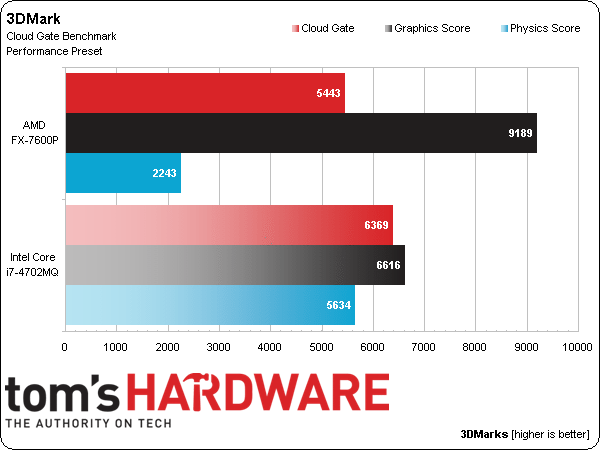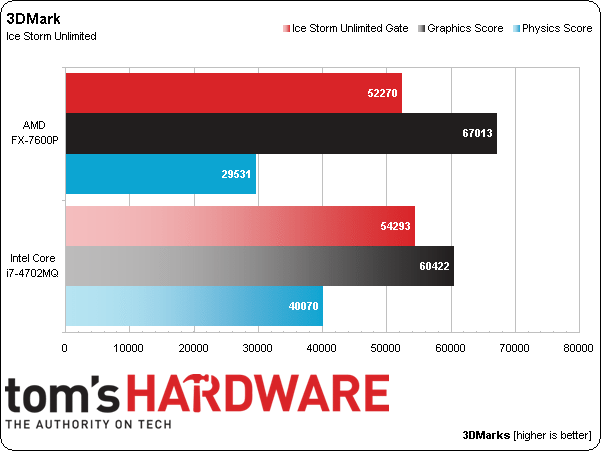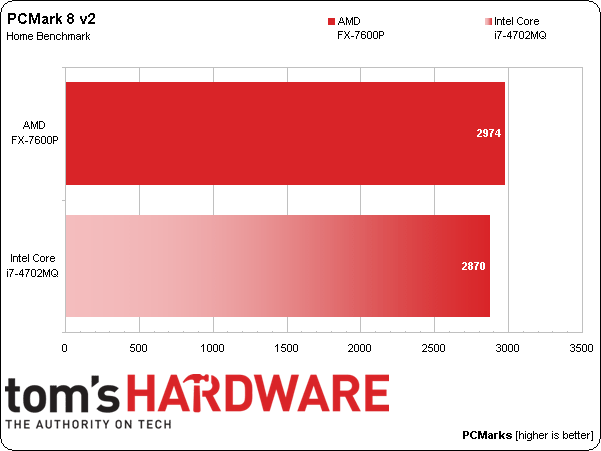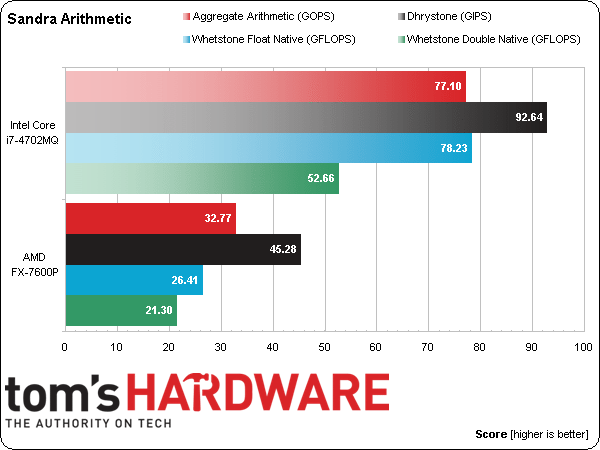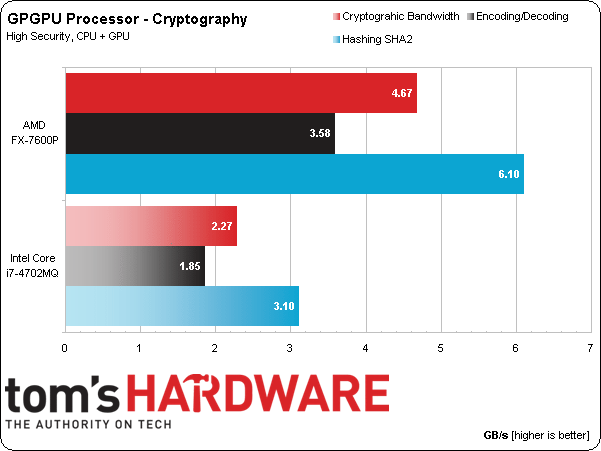AMD FX-7600P Kaveri Review: FX Rides Again...In A Mobile APU?
Results: Synthetic Benchmarks
We begin with 3DMark's synthetic graphics tests. More than likely, you already guessed that AMD's graphics engine would trump Intel's HD Graphics 4600 solution. But can the updated Steamroller architecture stand up to the efficient Haswell design?
Futuremark's Cloud Gate benchmark humbles this specific implementation of Kaveri, which features two Steamroller modules in what AMD likes to call a quad-core configuration. Because the Core i7 is a Hyper-Threaded quad-core solution, scheduling eight threads at a time, it has little trouble dominating. The Ice Storm Unlimited metric is a little more forgiving to AMD.
In both tests, AMD presents a compelling graphics story. However, Intel gets the aggregate advantage due to its superior execution cores.
AMD claims that Kaveri can hang with Haswell when it comes to PCMark's Home suite, though. How does that one pan out?
Indeed, the FX establishes a slight advantage. This is probably a fairly accurate reflection of the user experience in simpler tasks that don't come close to touching the APU's thermal ceiling.
Sandra's Arithmetic module helps quantify the theoretical superiority of Intel's x86 logic, which we already know to be quite fast in single-threaded and more parallelized workloads. But...
If we go the other way to show what AMD's OpenCL efforts enable, the combined potential of host processing and graphics together heavily favor the FX processor.
Get Tom's Hardware's best news and in-depth reviews, straight to your inbox.
Granted, there still aren't many OpenCL-accelerated apps. However, the situation is changing slowly. Though it's safe to say that most software benefits more from Intel's efficient architecture, we've seen a number of tasks sped-up dramatically by optimizations for general-purpose computing on graphics hardware. AMD needs to continue beating that drum if it hopes to change the way software is programmed.
Current page: Results: Synthetic Benchmarks
Prev Page The Mobile Kaveri Test Platform Next Page Results: Battlefield 4Don Woligroski was a former senior hardware editor for Tom's Hardware. He has covered a wide range of PC hardware topics, including CPUs, GPUs, system building, and emerging technologies.
-
damric Reply13432106 said:Are we ever going to get some new CPUs for the AM3+ socket?
I sure hope not. North Bridges and HT Link are so 5 years ago.
-
Lord_Kitty 20% IPC boost with Steamroller? (First page, second picture)Reply
That's enough for their 8-core chips to catch up or surpass current i5s, right? -
roymustang Rather than posting what we already know will be crappy framerates of recent games I wish that when outlets reviewed iGPUs they used some old games to see how those would run. Nobody buys a mobile APU expecting to use it for Battlefield 4. But people do like running older games on their APUs because those will most likely run decently. It would be nice to see how something like Final Fantasy XI or Knights of the Old Republic would run on this. Final Fantasy XI even has a benchmarking tool called Vana'diel Bench 3.Reply -
Amdlova 45w tdp on notebook. i think will we see some 17" + notebooks. don't put on your legs or you fry it!Reply -
Sakkura Reply
I agree, though it still makes sense to keep one demanding game in the test suite to give perspective on where this hardware stands compared to dedicated graphics cards and high-end CPUs.13432397 said:Rather than posting what we already know will be crappy framerates of recent games I wish that when outlets reviewed iGPUs they used some old games to see how those would run. Nobody buys a mobile APU expecting to use it for Battlefield 4. But people do like running older games on their APUs because those will most likely run decently. It would be nice to see how something like Final Fantasy XI or Knights of the Old Republic would run on this. Final Fantasy XI even has a benchmarking tool called Vana'diel Bench 3. -
Saiki4116 Thanks for including Dota2 Benchmarks. I had experienced FPS drop on my current Laptop(almost dead with i5-450M and HD5470, 1366*768, 4GB RAM) due to overheating, I tried to reduce resolution and tried many configs, but the problem was there.I have let Raptor(AMD 's app) to adjust the profile for Dota2, after that I didn't face the problem.Reply -
mitcoes16 I miss 720p testings that is the resolution a clever player would use with this GPUsReply
1080p and demanding games are not good benchmarks for this GPUs you must use less demanding games or test lower resolutions It is not the same benchmarking F1s than Nascars or electric cars
